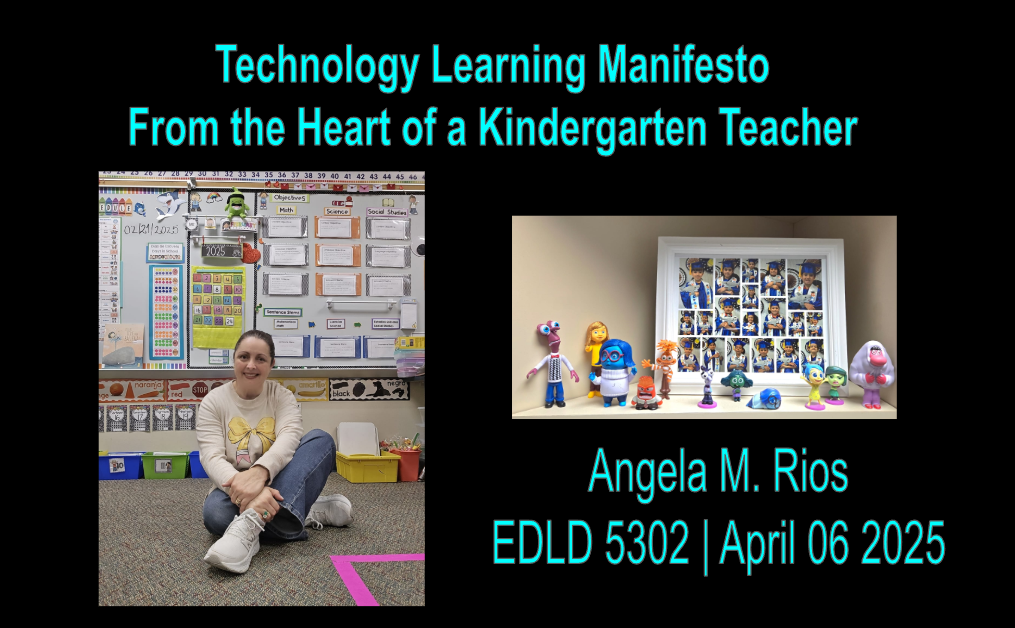
At the beginning of my journey in the Master’s Program in Digital Learning and Leading, I created a Learning Manifesto that helped me establish the foundation for what I believe is essential to my growth as an educator. In it, I reflect on the importance of authentic, meaningful, and student-centered learning. This manifesto not only represents my pedagogical values but has also guided my decisions when integrating digital tools in the classroom. Creating an ePortfolio allows me to showcase that professional evolution by demonstrating how my beliefs turn into concrete actions. The ePortfolio is not just a repository of assignments it is a space for ongoing reflection, where I connect what I learn with what I practice. It also allows other educators, colleagues, and academic leaders to see my progress, accomplishments, and future goals. In this sense, my Learning Manifesto serves as the compass for this entire process, which is why I am including it as a key element in this blog. If you would like to explore more about my educational vision and the principles that guide my practice, I invite you to view my manifesto here: Learning Manifesto.
Building my ePortfolio has been a truly enriching experience, especially since I had never created one before. I made mistakes, started over, and while I wouldn’t call it frustrating, it did push me to realize how persistent I can be. I committed myself to learning how to build it properly. I have a wonderful brother who is a robotics engineer, but I chose not to ask him for help because I knew how little free time he has. However, when I finally shared my progress with him, he was genuinely excited to see how eager I was to learn and he loved what I had created.
If someone asked me what I’ve learned while building my ePortfolio, I would say that I’ve learned to pay close attention to every detail because anyone reading it will see a reflection of who I am. In terms of technical skills, I’ve become more aware of how much I can learn from my surroundings. I’ve always been a deeply reflective person sometimes excessively so but that trait has helped me translate my thoughts into writing and articulate how I want to make a difference in my classroom. And why not? Perhaps I can even inspire others to collaborate in ways that benefit students.
One of the most valuable lessons I’ve learned in this journey is that my ePortfolio can become my new presentation letter. In the past, I imagined myself walking into an interview with a printed folder showcasing my achievements. But now, technology has empowered me to do this on another level. Learning how to create and personalize my ePortfolio has allowed me to express not just what I’ve done but who I am as a professional.
One of the most inspiring academic frameworks that has guided this process is the COVA model (Choice, Ownership, Voice, and Authentic learning). It has taught me that true collaboration enriches not just ourselves but also others through thoughtful and inspiring analysis. Dr. Dwayne Harapnuik’s work on this model promotes autonomy, authenticity, and a connection to meaningful learning. His ideas helped me rethink assessment not as something rigid and traditional, but as an opportunity for growth through ongoing reflection.
In addition, Gardner Campbell’s concept of Personal Cyberinfrastructure deeply influenced how I approached my ePortfolio. He inspired me to become the owner of my digital identity by creating and controlling a digital space that reflects who I am free from imposed formats, yet designed with purpose and intention. Campbell advocates for “learning by doing,” which has strengthened my critical thinking and digital autonomy skills that are increasingly essential in today’s fast-evolving technological world. Thanks to his perspective, I’ve also redefined what it means to be reflective, critical, and creative in my learning journey.
Conclusion: A Living Reflection of Who I Am
This ePortfolio is more than just an academic requirement it’s a living reflection of my voice, growth, and goals. It tells my story not only as a student but as an evolving educator. I now see this platform as a powerful way to share my work, connect with others in the education field, and inspire meaningful collaboration. In future job interviews, presentations, or professional conversations, I will carry this ePortfolio proudly knowing that it represents both my past learning and the path I continue to build.
References
Campbell, G. (2009). A Personal Cyberinfrastructure. EDUCAUSE Review. https://er.educause.edu/articles/2009/1/a-personal-cyberinfrastructure
Harapnuik, D. (2016). COVA: Choice, Ownership, Voice, and Authentic Learning. https://www.harapnuik.org/?page_id=6991